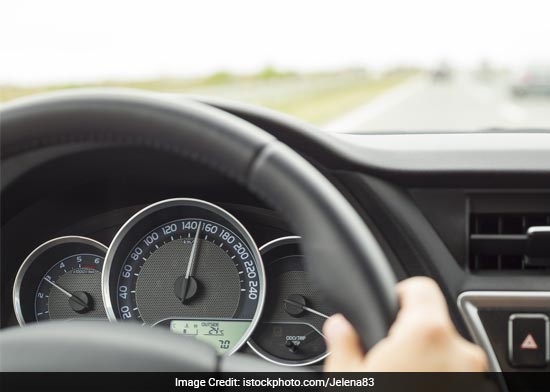
India’s Need For Speed Is The Biggest Impediment To Road Safety
32-year old Siddharth Sharma picks up a takeaway from a Chinese stall and begins to cautiously cross a road at Delhi’s Civil Lines. Nearly halfway through, he suddenly spots a speeding car and tries to jump aside, but is hit. The impact flings him 15 meters into the air and, eventually, kills him. The car was being driven at 100 km/hour; double the 50 km/hour speed limit. This horrifying accident played out for millions in India in a viral CCTV video in April, 2016. And unfortunately, incidents like this seem to be a recurring narrative on Indian roads. Just recently, on January 22, a cab driver was left dead after a speeding car rammed into his vehicle from behind.
Read More: Can Delhi Remove The Tag Of Being The ‘Overspeeding’ Capital Of India
Speed is the single largest killer on India’s roads. According to data compiled by the Ministry of Road Transport and Highways, in 2015, 44.2 per cent (64,633 out of 1,46,133 deaths) of road accident deaths were a direct consequence of overspeeding, while of the total accidents 47.9 per cent (2,40,463 out of 5,01,423 accidents) were linked to this.

Also Read: How Dangerous Are India’s Roads?
“The thing is that the higher the speed, the greater the impact and the more the chances of grievous injury and death. This is why speed management is something which needs to be seriously considered,” says Dr. Sewa Ram, Professor of Transport Planning, School of Planning and Architecture, New Delhi.
Regulating Speed
“Most urban roads are not built for speed, additionally its users are heterogeneous with vehicles with varying power and speed capabilities, pedestrians, cyclists and other non-motorised vehicles,” explains, Mohammad Imran, Founder of the Safe Road Foundation, a non-profit which works in the sphere of road safety.
In India urban speed limits vary for different states, roads and vehicle types. This does not meet the global standards defined by the World Health Organisation (WHO), which requires countries to have a national urban maximum speed limit of 50 km/hour. Some states like Uttar Pradesh fall below this bracket with a 40 km/hour limit while those in Andhra Pradesh and Maharashtra can go up to 65 km/hour.
Read More: Dangerous Roads: How India Compares To The World
However, the awareness about these limits is extremely low, according to according to Mr. Imran. “This leads to the fact that overspeeding is a major problem on our roads,” he says, “What happens when people overspeed is that they are unable to control the car. This is something that people fail to anticipate. They find it difficult to maintain the gap between vehicles because no one is running at a uniform, regulated speed which causes collisions.”
And this is precisely what happened in the recent BMW hit and run case. According to the WHO, the vulnerability of road users increase as the speed increases. An adult pedestrian has less than a 20 per cent chance of dying if struck by a car at less than 50 km/hour, however, this probability jumps to 60 per cent if hit by a vehicle moving at 80 km/hour.

Grossly Inadequate Enforcement
The currently applicable law, the Motor Vehicles Act 1988, prescribes a fine of up to ₹400 for a person caught driving at a speed above the applicable limit. For second-time offenders, this could go up to ₹1,000. This figure has been revised to ₹2,000 for first-time offenders in the proposed Amendment to this Act, which has been pending for review with the Parliamentary Standing Committee on Transport, Tourism and Culture for nearly six months.
Read More: 10 Things To Know About The Motor Vehicles (Amendment) Bill 2016
However, according to experts, the law is not the real problem but its enforcement is.
It is no secret that this is one of the biggest gaps in India’s approach to road safety. In its assessment of the enforcement of speed limits, the WHO’s Status Report on Road Safety 2015 gives India an abysmal 3 on 10.
“The police force is stretched thin and they are unable to keep checks at night, which is when most of the cases of overspeeding happen,” says Mr Imran.
This is a view that Garima Bhatnagar, Joint Commissioner (Traffic), Delhi Police, also reiterates, saying that most of the accidents related to speeding happen between 12 am and 5 am, when the roads are relatively empty and the police manpower is low.
Going Forward
“We need night vision cameras and there should be warnings about these cameras beforehand—people will automatically slow down. Additionally, we can have digital speed meters that gauge and warn people if they are speeding,” suggests Mr. Imran.
Leveraging technology seems to be the best bet to combat India’s propensity to speed and lack of manpower to enforce regulations, and this is something that the Minister for Road Transport and Highways Nitin Gadkari has even stated on multiple occasions. Joint Commissioner Garima Bhatnagar says that the procedure to move in this direction has already started.
Watch: Government Is Pushing For Intelligent Traffic Systems: Nitin Gadkari
“Integrated traffic management proposals have been sent to the Ministry of Home Affairs. This includes speed detecting cameras and e-challans,” she tells NDTV, adding that she hopes that this will be implemented in the next few years.
This, along with creating behavioural change among road users, is possibly the best available options we currently have.


















